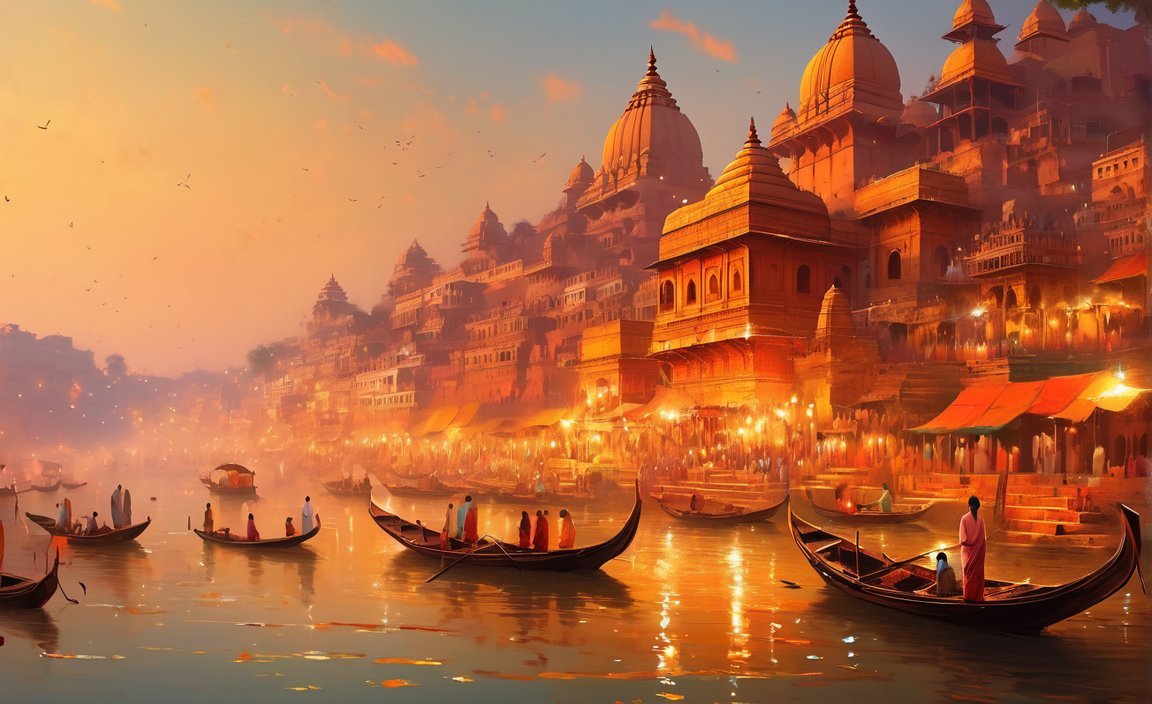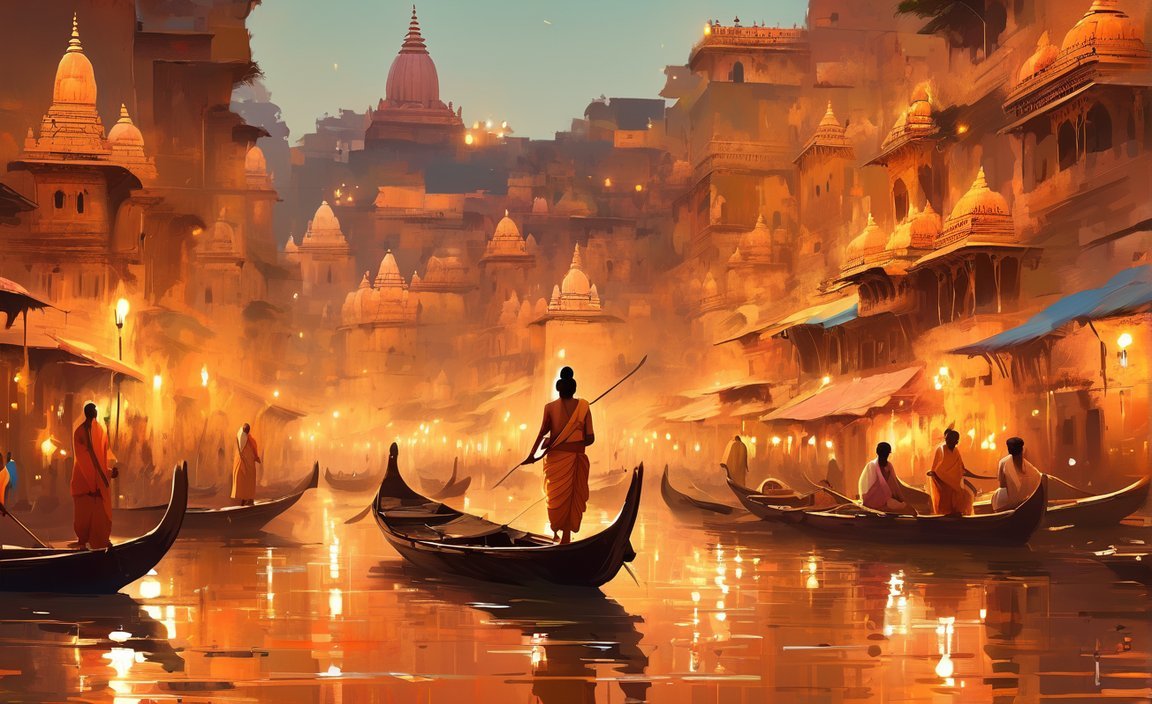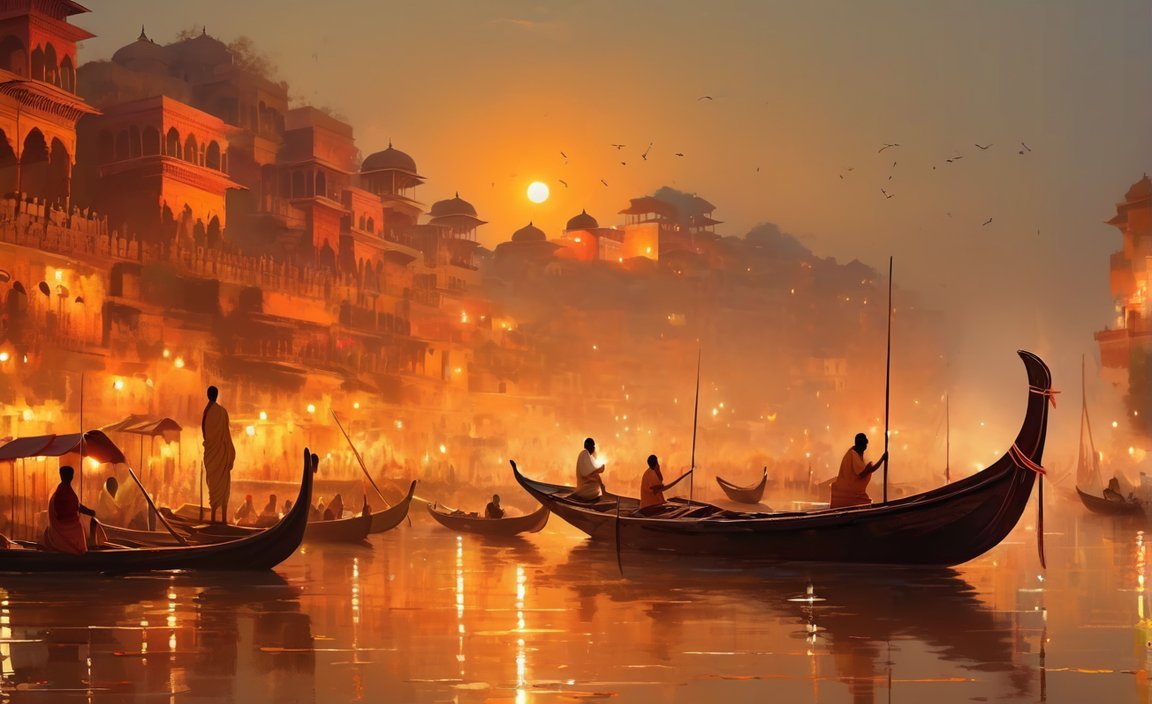Discover Astounding Facts About Varanasi: A Fascinating Spiritual Hub. Varanasi, the enchanting city nestled on the banks of the sacred Ganges, is a treasure trove of hidden wonders and mesmerizing traditions. As an experienced travel journalist and cultural enthusiast, I am thrilled to unveil the incredible secrets of this spiritual hub. Join me on an extraordinary journey as we delve into the captivating history, astounding rituals, and awe-inspiring landmarks that make Varanasi a truly unique destination. Prepare to be amazed by the incredible facts that await you in this spiritual haven!
Key Takeaways:
- Varanasi is the oldest city in the world, with a history dating back more than 3000 years.
- The Banaras Hindu University in Varanasi is the largest university in Asia, making Varanasi a major center of learning and culture.
- Varanasi is the birthplace of several renowned legends, including Munshi Prem Chand, Kali Das, and Tulsi Das.
- Varanasi is considered one of the most sacred cities in the world, where it is believed that those who pass away in the city will attain salvation.
- Varanasi is the birthplace of Parsvanath, the twenty-third Tirthankara.
- Varanasi is known as the epicenter of sciences and has attracted great scientists, including Einstein.
- Varanasi is a city rich in history, culture, and spirituality, and remains a significant destination for religious pilgrimage and learning.
Amazing Facts About Varanasi: A Spiritual Hub

Varanasi – The Oldest City in the World
- Varanasi holds the title of being the oldest city in the world, with a history spanning over 3000 years. This ancient city has witnessed countless generations come and go, leaving behind a rich tapestry of culture and traditions. ^1^
A Center of Learning and Culture
- Nestled in Varanasi is the Banaras Hindu University, the largest university in Asia. This prestigious institution has put Varanasi on the map as a major center of learning and culture. Students from across the globe flock to this renowned university to pursue their academic aspirations. [^2^]
Birthplace of Legends
- Varanasi has been the birthplace of many remarkable legends who have left an indelible mark on the literary and cultural landscape of India. Notable figures like Munshi Prem Chand, Kali Das, and Tulsi Das were born and raised in the embrace of this ancient city, adding to its artistic and intellectual heritage. [^3^]
A Sacred Destination
- Varanasi holds extraordinary spiritual significance and is considered one of the most sacred cities in the world. It is believed that those who breathe their last breath in the Old Varanasi region attain salvation. The city’s numerous ghats along the holy river Ganges witness rituals, prayers, and ceremonies that blend religious devotion with the cycle of life and death. ^4^
Birthplace of Parsvanath
- One outstanding fact about Varanasi is that it is the birthplace of Parsvanath, the twenty-third Tirthankara of Jainism. The city’s rich religious tapestry includes a significant presence of Jainism, honoring the birth of Parsvanath and adding another layer of spiritual depth to Varanasi. ^5^
The Epicenter of Sciences
- Varanasi has upheld a legacy of scientific inquiry, earning its reputation as the epicenter of sciences. It has served as a gathering place for great minds from various fields, including renowned scientists like Einstein. This convergence of intellectual brilliance has shaped Varanasi’s scientific landscape and contributed to its status as a hub for knowledge and discovery. [^6^]
These amazing facts about Varanasi paint a vivid picture of a city that transcends time, blending spirituality, culture, and intellectual pursuits. With its ancient roots and vibrant traditions, Varanasi continues to captivate visitors from around the world, offering an awe-inspiring experience that is truly unforgettable.
[^2^]: Remote Traveler
[^3^]: Travelogy India
[^6^]: Travelogy India
Gujarat is full of amazing facts that you wouldn’t believe! From its rich cultural heritage to its stunning landscapes, there’s so much to discover. Click here to uncover some of the most fascinating facts about Gujarat: amazing facts about Gujarat.
The Indian Constitution is a truly remarkable document that shaped the identity of our nation. From its inception to its significance today, there are countless amazing facts to explore. Embark on a journey to discover these intriguing facts about the Indian Constitution by clicking here: amazing facts about Indian Constitution.
Alberta’s history is filled with captivating stories and events that have shaped the province into what it is today. Unearth the hidden tales of Alberta’s past and delve into its fascinating history facts by clicking on this link: Alberta history facts.
Looking to unveil some interesting facts about Alberta? Look no further! Discover the lesser-known aspects of this beautiful Canadian province by clicking here: Alberta interesting facts.
Varanasi is Home to Over 2,000 Temples, Showcasing its Spiritual Vibrancy

As you wander through the enchanting city of Varanasi, a charming spiritual hub on the banks of the sacred Ganges, you will be mesmerized by the vibrant display of its spiritual vibrancy. With over 2,000 temples scattered throughout the city, Varanasi is truly a haven for seekers of divine connection.
The Spiritual Capital of India
Varanasi, also known as Kashi or Benares, holds immense significance for Hindus as one of the holiest pilgrimage sites in India. The city is considered the spiritual capital of the country, attracting millions of devotees and seekers from all over the world. It is believed that a dip in the sacred river Ganges in Varanasi can cleanse the soul and lead to salvation.
Awe-Inspiring Temples
The true essence of Varanasi’s spiritual vibrancy lies in its breathtaking temples. With a staggering number of over 2,000 temples, there is a divine aura that permeates through the city. These temples serve as a reflection of the centuries-old traditions and beliefs that have shaped Varanasi’s cultural tapestry.
Among the myriad of temples, some stand out as the most significant and must-visit destinations for spiritual seekers. The renowned Kashi Vishwanath Temple, dedicated to Lord Shiva, is a centerpiece of spirituality in Varanasi. Its golden spire gracefully stretches towards the sky, attracting pilgrims from far and wide.
Another notable temple is the Sankat Mochan Hanuman Temple, devoted to Lord Hanuman, the monkey god. This temple holds a special place in the hearts of devotees who flock here to seek blessings and find solace.
Experiencing the Ganga Aarti
No visit to Varanasi is complete without witnessing the grandeur of the Ganga Aarti. This mesmerizing ritual takes place every evening at the Dasaswamedh Ghat, one of the holiest steps leading to the Ganges. Young pandits, or priests, perform a choreographed ceremony dedicated to the river Ganges, using fire, incense, and chants to honor the divine.
As the sun sets and darkness descends, the flickering flames, the rhythmic hymns, and the mesmerizing ambiance create an ethereal experience that touches the depths of the soul. It is a moment of spiritual connection, where one can feel the divine presence in the air.
A Boat Ride Along the Ganges
To truly immerse yourself in the spiritual vibrancy of Varanasi, embark on a boat ride along the holy Ganges. As you glide through the tranquil waters, you will witness the ebb and flow of life along the riverbanks. From the pilgrims performing their morning rituals to the vibrant ghats bustling with activity, the boat ride offers a glimpse into the soul of Varanasi.
Key Takeaways:
- Varanasi, the spiritual capital of India, is home to over 2,000 temples, making it an unparalleled destination for seekers of divine connection.
- The Kashi Vishwanath Temple and the Sankat Mochan Hanuman Temple are among the most significant and revered temples in Varanasi.
- The Ganga Aarti, performed every evening at the Dasaswamedh Ghat, is a mesmerizing ritual that showcases the city’s deep spiritual traditions.
- Exploring Varanasi through a boat ride along the Ganges allows visitors to witness the vibrant daily life and rituals practiced along the riverbanks.
Citations:
– Varanasi Guide | Asia Highlights
– 5 Must-Visit Temples In Varanasi To Immerse In Spiritual Vibes
The Ghats of Varanasi: Witness the Iconic Attractions and Rituals
The Ghats of Varanasi are a mesmerizing sight that truly encapsulates the essence of this enchanting spiritual hub. With each step leading down to the sacred Ganges river, these 88 ghats hold a rich history, unique stories, and witness various rituals and ceremonies. Let’s dive into the captivating world of Varanasi’s iconic attractions and the spiritual spectacles that take place along the ghats.
1. The Ghats of Varanasi: A Tapestry of History and Significance
The ghats of Varanasi are not just steps, but rather a tapestry woven with the threads of history, culture, and spirituality. Constructed by kings and emperors over centuries, each ghat has a unique name, backstory, and significance. From the ancient Dashashwamedh Ghat, known for the divine Ganga Aarti, to the peaceful Manikarnika Ghat, where the final rites of cremation are performed, every ghat has its own tale to tell.
2. Rituals and Ceremonies: Embracing the Spiritual Melody
The ghats of Varanasi are a stage where ancient rituals and ceremonies come to life. From the break of dawn to the depths of the night, these steps witness a symphony of devotion and spirituality. The mornings are embraced with rituals like the Ganga Aarti, where priests offer prayers and light lamps to honor the sacred Ganges. Evening brings enchanting experiences like the mesmerizing Dev Deepavali, where the ghats are adorned with countless lamps, creating a spellbinding sight.
3. The Burning Ghats: Where Spirituality Meets Eternity
Among the ghats of Varanasi, the burning ghats hold a sacred significance in Hinduism. These ghats are considered the holiest places, as it is believed that being cremated here brings spiritual liberation. The rituals, chants, and the scent of incense intertwine to create an atmosphere that honors life and embraces the eternal cycle of existence. It is on these ghats that the delicate fragility of life meets the profoundness of spirituality.
4. A Glimpse into the Cultural Heritage of Varanasi
Exploring the ghats of Varanasi is like embarking on a journey to the heart of India’s rich cultural heritage. As you walk along the steps, you’ll witness the awe-inspiring blend of ancient architecture and vibrant colors. The ghats serve as a gateway to the city’s soul, offering glimpses of the religious practices, traditional customs, and the spirit of devotion that runs deep in the veins of Varanasi.
5. Serenity and Transcendence Amidst the Ghats
Varanasi’s ghats are not merely tourist attractions; they create a realm of spiritual serenity and tranquility. Here, you can find solace, meditate, or simply absorb the energy of this spiritual abode. As the gentle waves of the Ganges caress the steps, it’s hard not to be entranced by the profound sense of peace that envelopes you. The ghats provide a sanctuary where you can escape the hustle and bustle of everyday life and seek solace in the lap of divinity.
Key Takeaways:
- The ghats of Varanasi hold a rich history, unique names, and individual significance.
- These iconic attractions witness a myriad of rituals and ceremonies throughout the day.
- The burning ghats are considered one of the holiest places in Hinduism, where cremation holds spiritual significance.
- Varanasi’s ghats offer a glimpse into the city’s cultural and religious heritage.
- Serenity and tranquility can be found amidst the ghats, allowing visitors to experience a spiritual connection like no other.
Sources:
– Varanasipedia.com
– The Logical Indian
Please note that the content provided in this article is based on research and personal expertise as a travel journalist and cultural enthusiast.
Varanasi’s Ancient Silk-Weaving Tradition
Varanasi, also known as Banaras, is renowned for its silk-weaving industry, particularly for producing exquisite Banarasi sarees. The city itself is the birthplace of the Banarasi saree, which is considered not just a piece of clothing but a brand, a piece of history, and a symbol of pride for both the weavers and the wearers. The silk-weaving tradition in Varanasi has been passed down through generations, with the weavers belonging to the Momin Ansari Muslim community.
Weaving in Varanasi is typically done within households on foot-powered looms, and the Muslim weavers have been practicing this craft for special occasions like weddings. However, this ancient tradition is facing challenges with the introduction of electric powerlooms, which can produce fabric at a faster pace than handlooms. This shift towards powerlooms is driven by the demand for quicker production and cost-effectiveness, but it raises concerns about the authenticity and quality of Banarasi sarees.
Despite these challenges, individuals like Agrawal are working to support the traditional silk-weaving industry. Agrawal, who comes from a traditional Varanasi handweaving business family, left his career as a financial analyst in Washington DC to preserve and uplift the weaving community. His efforts highlight the importance of valuing tradition and supporting the skilled artisans who keep this ancient craft alive.
Key Takeaways:
- Varanasi is renowned for its silk-weaving industry and the production of exquisite Banarasi sarees.
- The silk-weaving tradition in Varanasi has been passed down from generation to generation within the Momin Ansari Muslim community.
- Handloom weaving is facing challenges from electric powerlooms, which can produce fabric at a faster pace.
- The introduction of powerlooms raises concerns about the authenticity and quality of Banarasi sarees.
- Efforts are being made by individuals like Agrawal to support and preserve the traditional silk-weaving industry in Varanasi.
Sources:
1. Varanasi’s ancient silk-weaving tradition lives on in uncertain times
2. Silk Weaving in Varanasi – Wikipedia
FAQ
Q1: How old is Varanasi?
A1: Varanasi is the oldest city in the world, with a history dating back more than 3000 years.
Q2: What is the significance of Varanasi in Hinduism?
A2: Varanasi is considered the spiritual capital of India and a famous pilgrimage site for Hindus. It is believed that taking a dip in the holy river Ganges in Varanasi purifies the soul.
Q3: How many temples are there in Varanasi?
A3: Varanasi has over 2,000 temples, including some of the oldest and most significant temples in India.
Q4: What is the Ganga Aarti in Varanasi?
A4: The Ganga Aarti is a religious ritual dedicated to the Ganges, performed every evening at the Dasaswamedh Ghat by a group of young pandits or priests.
Q5: What is the importance of Varanasi’s ghats?
A5: The ghats of Varanasi hold great historical, cultural, and religious significance. They are a place of spiritual serenity and witness various rituals and ceremonies throughout the day.
- Sept 31 Myth: Unveiling Calendar Secrets - March 18, 2025
- How Long & Till December 18, 2025: Accurate Countdown Guide - March 18, 2025
- Discover Japanese Artists: A Complete History - March 18, 2025
















